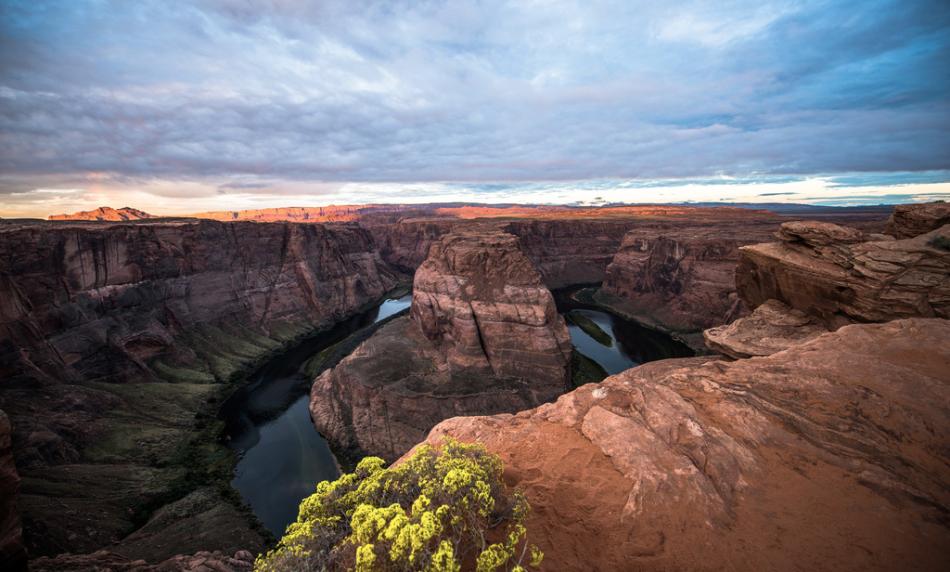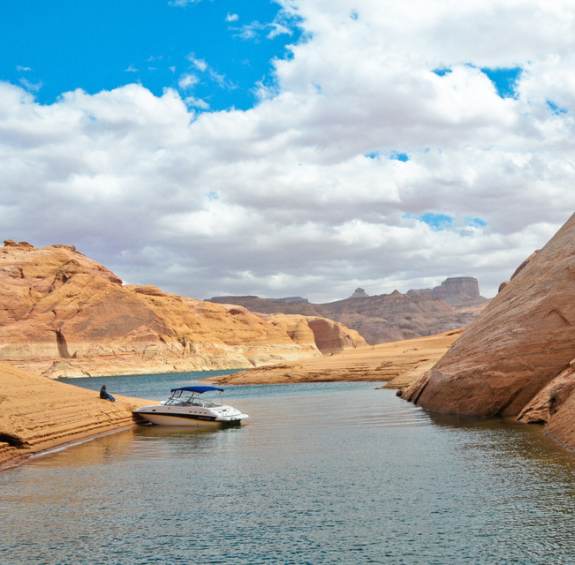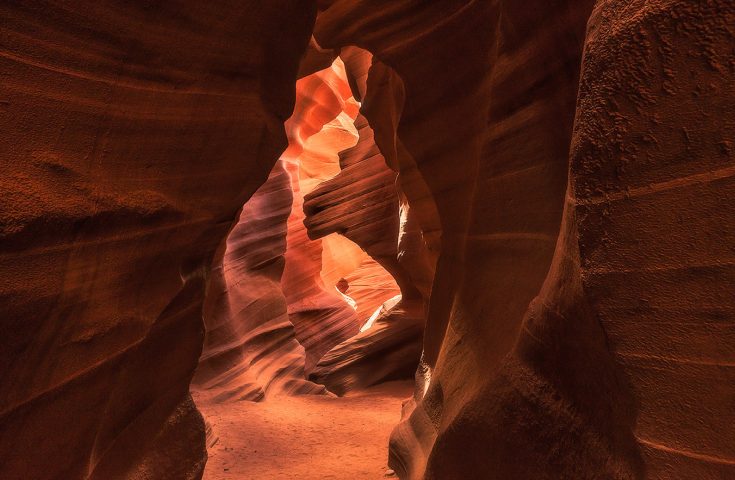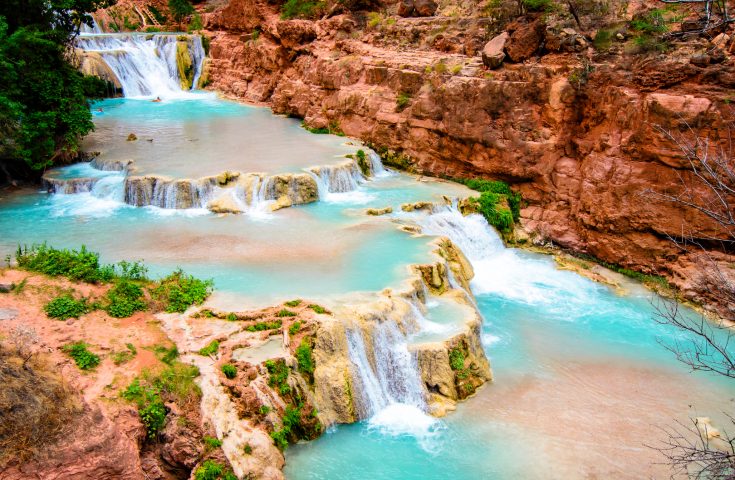
Must Do
A Guide to Visiting Horseshoe Bend 'the Right Way'
Horseshoe Bend attracts 2 million visitors every year and is one of the most photographed sites in northern Arizona. Here, we walk you through need-to-know details for how to travel to this spectacular place as well as tips on how to engage more meaningfully with the destination.
Formed when the Colorado River looped around an impassable sandstone escarpment, Horseshoe Bend is one of Glen Canyon National Recreation Area's more famous highlights. Not an easy feat, considering nearby is Antelope Canyon and the second-largest manmade lake in the United States, Lake Powell.
Getting to Horseshoe Bend
Start in Flagstaff, Arizona's third-largest city about two hours north of Phoenix. To get to Horseshoe Bend from Flagstaff, take Highway 89 north approximately 125 miles. Watch for the parking lot on the west side of the road at mile marker 544, just before entering the town of Page. If the lot is full, staff will ask you to return later. You are not allowed to park on the side of the road or drop anyone off.
The basics
When to go
Horseshoe Bend is open year-round from sunrise to sunset; however, most people visit from 9 to 11 a.m. and 4:30 to 6:30 p.m. to catch the sunset. Avoid the crowds by going at sunrise or on weekdays.
You'll encounter fewer visitors in the early afternoon, but temperatures peak during these hours, and the canyon walls lack the vibrant colors they have earlier and later in the day thanks to the intensity of the sun's rays.
What you'll need
Water is a must, especially during the summer. Bring 1 liter per person for every two hours. Pack light snacks, and dress appropriately for a desert hike. You should wear:
- Closed-toe shoes (no sandals!)
- Sunglasses
- Wide-brimmed hat
- Sunscreen—there's very little shade on the trail or at the rim
What it costs
Although the national park service doesn’t charge an admission fee to Horseshoe Bend, the parking lot is located on property owned by Page. The city charges $10 per vehicle or RV and $5 per motorcycle to park in the lot. National park passes do not entitle you to a discount.
What to bring
You'll definitely want a camera, preferably with a wide-angle lens. (Most cell phones can capture the view using a wide-angle setting or in panorama mode.) If you don’t have a telephoto lens, consider bringing binoculars to watch rafters navigating the river's bend below. Drones are not allowed.
If you visit during the winter, dress in layers. You'll likely break a sweat while hiking, but expect to get cold standing on the rim, especially if the wind is blowing.
The trip itself
A new trail that meets Architectural Barriers Act (ABA) standards winds .6 miles from the north end of the parking lot to a fenced overlook added in 2018. For a barrier-free view of the blue-green waters below, venture to either side of the overlook. There, you can appreciate the iconic scenery, set up a tripod to capture the sunset or pose for a picture with your travel companions.
Just don't venture too close to the edge! The sandstone can be slick, and the fall is more than 1,000 feet to the river below.
Plan to spend about an hour and a half visiting Horseshoe Bend, then take advantage of the rest of the day to explore Glen Canyon National Recreation Area. Start at the Carl Hayden Visitor Center (on Highway 89, two miles north of Page), where you can tour Glen Canyon Dam, the second-highest concrete-arch dam in the United States after Hoover Dam. (Check the website for opening hours and contact information.)
Or, head into the recreation area itself to explore the area further. Admission is $30 per vehicle and remains valid for seven days. You can rent a houseboat, powerboat or kayak from the Wahweap Marina, or if you prefer to stay on dry land, you can hike the trails surrounding Lake Powell. Off-highway vehicle (OHV) trails allow you to access even more of the area's backcountry. Guided tours let you enjoy the area from a boat or helicopter with the aid of knowledgeable guides.
Another stunning destination, Antelope Canyon is less than 10 miles from Page. Visiting this slot canyon—a magnificent site formed from millions of years of erosion—is only allowed with a tour guide. Book one in Page to ensure you'll be able to visit.

A note about water levels
Water levels at Lake Powell hit a historic low in 2021, forcing some marinas and other area services to limit or suspend all activities.
For more information on current water levels and impacted services, including ramp launches, please visit the National Park Service's Changing Lake Levels page for Glen Canyon.
Where to stay
Because there is so much to see in the area—Lake Powell, Antelope Canyon, Rainbow Bridge National Monument, Vermilion Cliffs National Monument, Lees Ferry and more—most visitors choose to spend several days in Page. There are more than 300 hotels, motels and vacation rentals in the area; here are two to get you started.
Lake Powell Resort: This Aramark-managed resort inside the recreation area is a short walk from Wahweap Marina and popular with visitors who want to get out on the water. Rent a powerboat for the day, then savor a meal as the sun sets over the lake at the onsite restaurant.
Hyatt Place Page/Lake Powell: One of the newer accommodations in the area, this hotel scores high marks with visitors for its outstanding views of the lake as well as its exceptionally clean rooms and hot breakfast. It also features accessible rooms and spaces throughout the hotel, plus it's pet-friendly.
Leave No Trace
Horseshoe Bend is a special place whose breathtaking beauty and natural habitats for local wildlife are worth preserving. Adhere to the Leave No Trace principles as much as you possibly can so future visitors may continue to enjoy.
Visit Arizona's Top Spots
the 'Right Way'
Must Do
A Guide to Visiting Antelope Canyon the 'Right Way'
Antelope Canyon's otherworldly beauty makes it one of the most highly sought after destinations in the world, and access to this natural marvel...
Must Do
A Guide to Visiting Havasu Falls the 'Right Way'
Topping the bucket list of bucket lists, Havasu Falls in the Grand Canyon is one of the most sought after destinations in the world. But getting...






